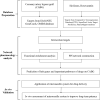Prevention of neointimal hyperplasia after coronary artery bypass graft via local delivery of sirolimus and rosuvastatin: network pharmacology and in vivo validation
- PMID: 38365767
- PMCID: PMC10874014
- DOI: 10.1186/s12967-024-04875-8
Prevention of neointimal hyperplasia after coronary artery bypass graft via local delivery of sirolimus and rosuvastatin: network pharmacology and in vivo validation
Abstract
Background: Coronary artery bypass graft (CABG) is generally used to treat complex coronary artery disease. Treatment success is affected by neointimal hyperplasia (NIH) of graft and anastomotic sites. Although sirolimus and rosuvastatin individually inhibit NIH progression, the efficacy of combination treatment remains unknown.
Methods: We identified cross-targets associated with CABG, sirolimus, and rosuvastatin by using databases including DisGeNET and GeneCards. GO and KEGG pathway enrichment analyses were conducted using R studio, and target proteins were mapped in PPI networks using Metascape and Cytoscape. For in vivo validation, we established a balloon-injured rabbit model by inducing NIH and applied a localized perivascular drug delivery device containing sirolimus and rosuvastatin. The outcomes were evaluated at 1, 2, and 4 weeks post-surgery.
Results: We identified 115 shared targets between sirolimus and CABG among databases, 23 between rosuvastatin and CABG, and 96 among all three. TNF, AKT1, and MMP9 were identified as shared targets. Network pharmacology predicted the stages of NIH progression and the corresponding signaling pathways linked to sirolimus (acute stage, IL6/STAT3 signaling) and rosuvastatin (chronic stage, Akt/MMP9 signaling). In vivo experiments demonstrated that the combination of sirolimus and rosuvastatin significantly suppressed NIH progression. This combination treatment also markedly decreased the expression of inflammation and Akt signaling pathway-related proteins, which was consistent with the predictions from network pharmacology analysis.
Conclusions: Sirolimus and rosuvastatin inhibited pro-inflammatory cytokine production during the acute stage and regulated Akt/mTOR/NF-κB/STAT3 signaling in the chronic stage of NIH progression. These potential synergistic mechanisms may optimize treatment strategies to improve long-term patency after CABG.
Keywords: Inflammation; Intimal hyperplasia; Network pharmacology; Rosuvastatin; Sirolimus.
© 2024. The Author(s).
Conflict of interest statement
The authors have no competing interests to declare.
Figures











Similar articles
-
Effect of sequential release of sirolimus and rosuvastatin using silk fibroin microneedle to prevent intimal hyperplasia.Biomed Pharmacother. 2023 Dec;168:115702. doi: 10.1016/j.biopha.2023.115702. Epub 2023 Oct 12. Biomed Pharmacother. 2023. PMID: 37837879
-
Jingfang granule alleviates Pseudomonas aeruginosa-induced acute lung inflammation through suppression of STAT3/IL-17/NF-κB pathway based on network pharmacology analysis and experimental validation.J Ethnopharmacol. 2024 Jan 10;318(Pt A):116899. doi: 10.1016/j.jep.2023.116899. Epub 2023 Jul 15. J Ethnopharmacol. 2024. PMID: 37454750
-
Understanding apoptotic induction by Sargentodoxa cuneata-Patrinia villosa herb pair via PI3K/AKT/mTOR signalling in colorectal cancer cells using network pharmacology and cellular studies.J Ethnopharmacol. 2024 Jan 30;319(Pt 3):117342. doi: 10.1016/j.jep.2023.117342. Epub 2023 Oct 23. J Ethnopharmacol. 2024. PMID: 37879505
-
A network pharmacology approach and experimental validation to investigate the anticancer mechanism and potential active targets of ethanol extract of Wei-Tong-Xin against colorectal cancer through induction of apoptosis via PI3K/AKT signaling pathway.J Ethnopharmacol. 2023 Mar 1;303:115933. doi: 10.1016/j.jep.2022.115933. Epub 2022 Nov 18. J Ethnopharmacol. 2023. PMID: 36403742
-
Study on molecular biological mechanism of Chinese herbal medicines for the treatment of gastric precancerous lesions based on data mining and network pharmacology.Zhejiang Da Xue Xue Bao Yi Xue Ban. 2022 Nov 25;51(5):573-584. doi: 10.3724/zdxbyxb-2022-0278. Zhejiang Da Xue Xue Bao Yi Xue Ban. 2022. PMID: 36581572 Free PMC article. English.
Cited by
-
Rosuvastatin activates autophagy via inhibition of the Akt/mTOR axis in vascular smooth muscle cells.Korean J Physiol Pharmacol. 2025 Jan 1;29(1):117-126. doi: 10.4196/kjpp.24.284. Epub 2024 Nov 14. Korean J Physiol Pharmacol. 2025. PMID: 39539182 Free PMC article.
References
-
- Brown JC, Gerhardt TE, Kwon E. Risk factors for coronary artery disease. Treasure Island: StatPearls; 2023. - PubMed
Publication types
MeSH terms
Substances
Grants and funding
LinkOut - more resources
Full Text Sources
Miscellaneous

